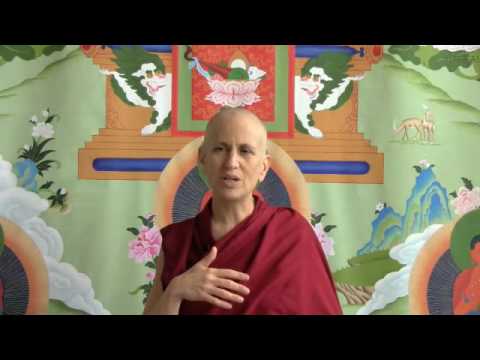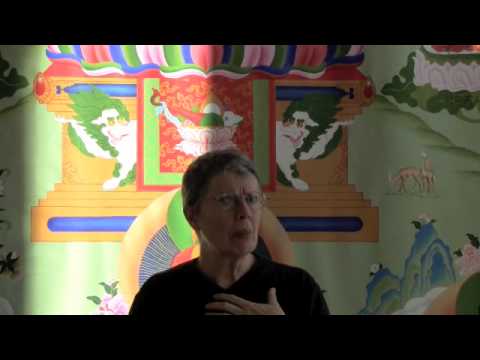The antidotes to fear
Part of a series of Bodhisattva's Breakfast Corner talks given during the Green Tara Winter Retreat from December 2009 to March 2010.
- Taking refuge in the face of fear
- Meditation on the cushion helps to change the way the mind works
- Considering karma and conditions
Green Tara Retreat 038: Antidotes to fear and anxiety (download)
We were talking about fear and anxiety and I promised to do my list of antidotes, which is actually kind of long because I’ve been working on this for a while. But I want to tell a story. Seattle had an earthquake; a pretty big one (7.something). It’s probably been 10 years ago now, something like that. It was very deep and did a lot of damage to buildings. But it wasn’t deadly for people. Khensur Wangdak Rinpoche was doing the first day of his teaching at Dharma Friendship Foundation. That night when we came in to receive the teaching, Roy, his translator, told a story about Rinpoche. The earth had started shaking and it shook for a long time. We’ve been in little earthquakes. We have a little tremor and it shakes for a few seconds. But this went on and you knew you were in an earthquake. Once Roy figured out what it was, he went back to Rinpoche and said, “Rinpoche, Rinpoche, it’s an earthquake! We have to get out of here!” Rinpoche was taking refuge and said, “I am taking refuge. I am just taking refuge.” Roy could not get him to budge because Rinpoche was taking refuge.
I just thought that was the best possible teaching for how to deal with fear in the moment. If Khensur Wangdak Rinpoche was not leaving that apartment because he was taking refuge, that would be a really good thing for me to practice. So I do try to do that when I’m on airplanes about to take off. I think, “If this plane goes down, what am I going to do?” I take refuge then. They talk about doing self-defense training (training in the adrenaline state), so that when adrenaline is running your mind is set to do the things that will defend you. I’ve been trying for many years to take refuge in the adrenaline state—when I feel that fear coming up. I don’t always remember. But by really being mindful about practicing, it has become a very good habit and a resource. It comes to my mind immediately. That’s one good especially in the question, “What do you do when the building is burning?” What else is there to do? We take refuge. We take refuge. We take refuge and all of the things that means, comes to mind, depending on how much I’ve reflected on that.
So then, more along the anxiety line which is where this whole conversation started. Most of these antidotes I’ve worked with are more systemic. I have to do a fair amount of meditation on the cushion just to change the way my mind works in general. On the spot, I am getting better at mindfulness of the body and trying to be aware of how that feeling feels, what’s happening in my body when I’m starting to feel anxious. If I begin to catch that, I simply ask the question, “What’s the problem? What am I feeling anxious about?” Often, in my own case, if somebody else is anxious then I feel like I have to fix it and I get anxious too. If I can catch the feeling when it comes up then I think, “Wait a minute, this is not even my problem. Calm down.” So, that’s helpful.
The more systemic ones are actually what have led to making this possible. One is really using purification practice to work with fear and anxiety. Try to imagine, “If I have this kind of chronic fear, especially in terms of people’s anger, what must I have done in the past that would make this happen? How have I terrorized others? Was I a prison guard and just abused people? Was I a matron in an orphanage that abused and terrorized the children? Was I a hawk flying over the chicken yard?” I was probably all of those things, all of those possible ways of frightening other beings, or I wouldn’t have this. It’s a pretty regular part of either my 35 Buddhas purification practice or sometimes Vajrasattva, too. I’m really using that to purify the negativity of creating this kind of fear in others. So, that’s one thing I do.
Because my own anxiety rises very much from attachment to reputation, and also attachment to nice, reassuring words, and an aversion to hearing harsh words, I meditate on antidotes to those attachments. “What is someone’s opinion? What is reputation?” It’s an opinion in people’s minds, the thought in a group of people’s minds. Who even knows in how many minds it’s a thought. To begin, just think, “What is there to be frightened about in terms of what people think? I have no control over what they think, and I don’t know what they think.” And so, to convince myself again and again, I use these kinds of antidotes—that having this sort of attachment is like having an attachment to what? In some ways, attachment to material things makes more sense than attachment to praise or reputation, because the latter so intangible. You can’t even feel it. It doesn’t exist! So that kind of reduces the worry immediately.
Another antidote has been to really rely on Tara as a role model. I found that to be very helpful. That first praise, “Tara is swift and fearless” She’s not afraid of anything so use that kind of mind. Why not? Her incredible compassion, her incredible wisdom, she knows the nature of reality. I use that as a role model and really use the praises to Tara, especially when I am up against something that’s starting to feel a little bit edgy. Doing those praises to Tara brings a tremendous feeling of courage and confidence. That’s another useful antidote.
I would say that the one that was most helpful in starting to take the whole thing apart has come from Geshe Sopa’s teaching on Shantideva’s chapter on patience in Guide to a Bodhisattva’s Way of Life, when he talks about the conditioning of how these feelings arise, especially if I’m afraid of somebody else’s anger. One of these verses says, “Anger does not say I intend to arise.” It simply arises based on conditions. A person does not say, “I intend to be angry.” Anger arises because of their conditions. A few more verses down, he says, “Whenever you see a friend or an enemy engaging in an unwholesome activity, simply think, such are their conditions and be at ease.” That phrase, “Such are his conditions, such are her conditions, and be at ease,” helps me so much to see that whatever is happening in a person that I’m afraid of, is arising through their conditions. The feeling that I’m having is arising due to my own conditioning. So to just to say, “Oh, these are just our conditions, and be at ease” has been extremely helpful in starting to take apart my own reactivity in terms of anxiety. Now that one actually does comes up in the moment after meditating on it quite a bit.
In a way, it’s a list I’ve given and there are quite a few ideas. But surely somewhere there is one that might be useful for people who deal with this problem. I think the Dharma gives us infinite resources to pull those little medicines out of a “Dharma medicine kit” and to deal with our afflictions, which are our illnesses. So those are my antidotes.
Venerable Thubten Chonyi
Ven. Thubten Chonyi is a nun in the Tibetan Buddhist tradition. She has studied with Sravasti Abbey founder and abbess Ven. Thubten Chodron since 1996. She lives and trains at the Abbey, where she received novice ordination in 2008. She took full ordination at Fo Guang Shan in Taiwan in 2011. Ven. Chonyi regularly teaches Buddhism and meditation at the Unitarian Universalist Church of Spokane and, occasionally, in other locations as well.


